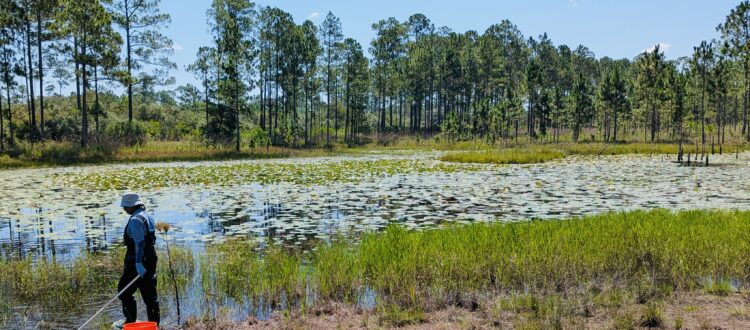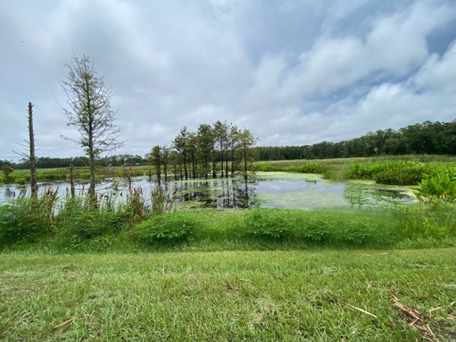Hydro Highlight: Chamoda Dissanayake — Protecting Florida’s Drinking Water, One Wetland at a Time
Wearing chest-high waders, Chamoda Dissanayake sloshes through the cool water, feeling the squishy, yielding earth and slippery, tangled plant life brush against her with each step. Gripping the long-handled dipper, she lowers it into the water to collect a water sample to bring back to the lab for analysis. The wetland around her hums with the sounds of birds and flowing water, a carefully crafted ecosystem that murmurs with life. The water she collects comes from the nearby wastewater treatment plant before it travels through the wetland to our aquifer. In Florida, these engineered wetlands play a vital role in modern wastewater treatment, safeguarding our water supply.
 Chamoda approaching a natural wetland to sample with a water dipper in hand.
Chamoda approaching a natural wetland to sample with a water dipper in hand.
For Chamoda, a Ph.D. student in the School of Forest, Fisheries, and Geomatics Sciences at the University of Florida and a UF Water Scholar, this work is about more than data collection. It’s about protecting life itself.
What is Reclaimed Water?
Reclaimed water is wastewater from residential and municipal sources that is treated and reused for irrigation, industry, and groundwater recharge to reduce stress on existing water supplies. This water can contain higher levels of nutrients, metals, per- and polyfluoroalkyl substances (PFAS), microplastics, and other substances that are not regulated. Treatment processes aim to be both effective and cost-efficient, ensuring compliance with water quality standards for reuse.
What is an Engineered Wetland?
Wetlands, often called “nature’s kidneys,” naturally remove harmful nutrients and chemicals from wastewater sources—such as stormwater and agricultural runoff—before they reach rivers, lakes, and coastal waters. Scientists and engineers have developed engineered (also known as constructed) wetlands that mimic the functions of natural wetlands. Specifically, they are used for treating wastewater before it causes algae blooms in a receiving ecosystem or reaches the Floridan Aquifer, the source of drinking water for 90% of Floridians.
“My goal is to understand how human activity affects our water and how we can use natural processes to restore it. Clean water is essential to every community, everywhere.”
– Chamoda Dissanayake
Originally from Sri Lanka, Chamoda has long been passionate about water quality and ecology. Her undergraduate research at the University of Sri Jayewardenepura, Sri Lanka, examined how urbanization impacts water quality and fisheries in freshwater ecosystems. After being an academic instructor for three years, she discovered a project at the University of Florida that explored how plants could be used to reduce nutrients from urban stormwater runoff. The idea of using nature to heal nature resonated deeply with her, so much so that she moved halfway across the world to pursue it during her master’s degree.
Research Background & Motivation
Florida leads the nation in water reuse, with wastewater treatment facilities capable of reusing nearly 891 million gallons per day. As urban populations increase and freshwater resources become increasingly limited, reclaimed water has become essential for irrigation, industry, and groundwater recharge.
This growing reliance on reclaimed water raises an important question: how can we ensure that it is treated safely and sustainably before returning to the environment? One promising approach is the use of engineered wetlands. But how well do these engineered wetlands perform compared to natural wetlands?
That question is at the core of Chamoda’s research, which seeks to understand how chemical signatures differ between engineered and natural wetlands, focusing on identifying the specific chemical parameters that drive these differences, how these signatures change across different constructed wetland designs, and what that means for the future of water reuse in Florida.
“My objective is to unravel the impacts of urbanization on freshwater aquatic ecosystems and develop effective strategies to mitigate these negative effects through best management practices.”
– Chamoda Dissanayake
 An engineered wetland that is part of Chamoda’s study.
An engineered wetland that is part of Chamoda’s study.
Much of the research on engineered wetlands has focused on how effectively they remove pollutants, like nitrogen and phosphorus. Chamoda is taking a different approach by examining the chemical properties of water and sediments in constructed wetlands that specially treat reclaimed water and comparing them to those in natural wetlands. To do this, she will analyze various forms of nitrogen, phosphorus, and carbon (dissolved and particulate, inorganic, and organic) and organic matter quality, microbial activity, and their impact on nutrient cycling within these engineered ecosystems.
Why It Matters?
The findings will support collaborations with local managers and scientists to enhance wetland management practices across urban landscapes. By quantifying how well engineered ecosystems reduce nutrient loads — especially in rapidly growing states like Florida — her findings will help improve wetland design and inform policies that protect groundwater and surface waters. Ultimately, she hopes that understanding these systems better will help lessen the impact on our drinking water and save our remaining freshwater systems.
 Chamoda collecting water samples with a dipper in an engineered wetland.
Chamoda collecting water samples with a dipper in an engineered wetland.
Sharing Knowledge and Building Connections
Chamoda will be presenting her dissertation research at the upcoming Water Institute Symposium.
“I’m excited to present my work to a broader audience in water research, gather valuable feedback, identify key research gaps, and discuss future directions for my research projects. I look forward to connecting with fellow researchers and professionals from the environmental and water management sectors to discuss the challenges facing our freshwater ecosystems and explore opportunities to address them.”
– Chamoda Dissanayake
 Chamoda presenting at the 2024 UF Water Institute Symposium
Chamoda presenting at the 2024 UF Water Institute Symposium
This Hydro Highlight was created by the Water Institute Ambassadors Alexis Jackson and Lexi Bolger. Graduate students interested in being highlighted can fill out this survey to learn more.
November 4, 2025

